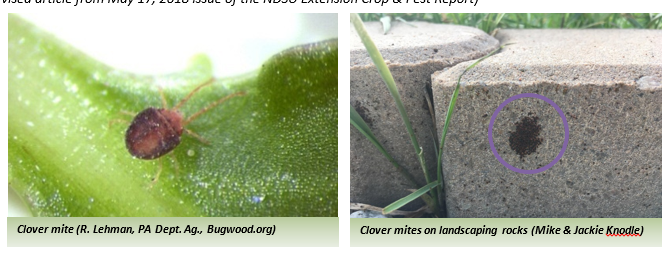Clover Mites in Homes (05/20/21)
Do you see small dots moving around on the inside of your window sill or climbing up the sides of the house on the sunny-side (south or west)? You are not seeing things. These are probably tiny clover mites called Bryobia praetiosa. These reddish-brown mites are cool-season mites and are active in spring and fall. They can be identified by their front legs that are about twice as long as the body and the other legs. Thousands of clover mites can invade a house through cracks in foundations or by crawling through the screens. They do not bite or sting people or pets. When crushed, they cause a blood-red spot that may stain the walls, curtains or carpets.
Clover mites feed on the plant juices of turf grasses, clover and even certain trees or shrubs. They are more common in newly established lawns or older lawns that have been heavily fertilized. For control, caulking any cracks or openings in the foundation will help prevent mites from getting into the house. A grass-free zone of 18-24 inches around the base of the house also can be an effective barrier against mites. Landscape rocks are not effective barriers to clover mites. Some plants are not attractive to clover mites including zinnia, marigold, salvia, rose, chrysanthemum, petunia, juniper, spruce, arborvitae and yew. These plants can be planted in the grass-free zone.
Insecticides registered for mite control and outside use around the house can be applied as a perimeter treatment around the base of the house, windows or doors to reduce mite infestations. Insecticide should be sprayed 3 feet up the side of the house and 3 feet out from the base. Applications should be applied during the warm part of day and concentrated in the area where mites are entering the house, such as the south side. Two insecticide active ingredients that are effective against mites are bifenthrin and malathion. There are many different trade names of insecticides for use the home owner. So, look for the correct active ingredient on the label on the back of bottle. The homeowner should be able to find these two active ingredients at any garden supply store. A vacuum or damp rag can be used to remove mites from inside the house.
(Revised article from May 17, 2018 issue of the NDSU Extension Crop & Pest Report)

Extension Entomologist


